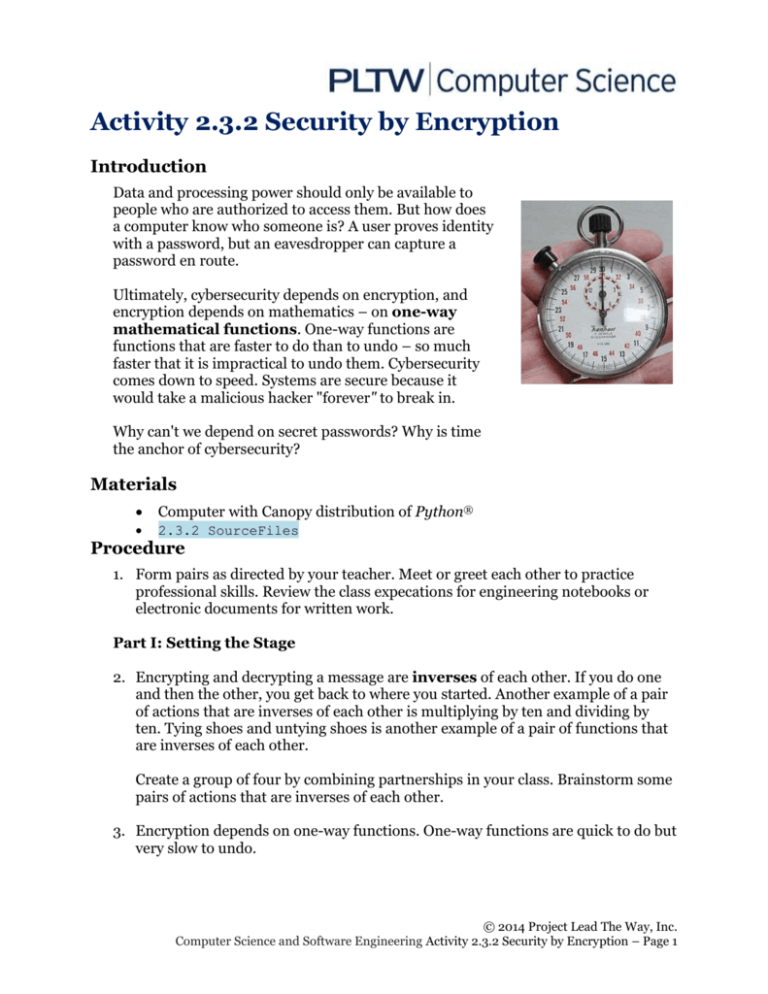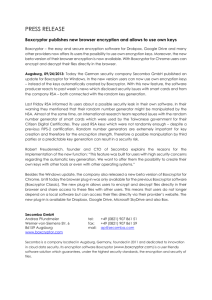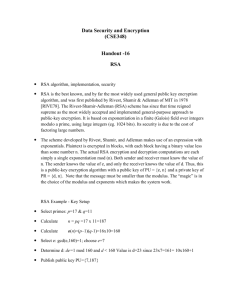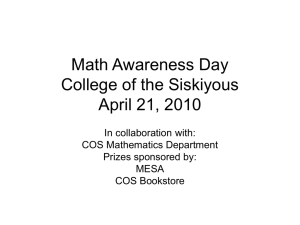2.3.2.A SecurityByEncryption
advertisement

Activity 2.3.2 Security by Encryption Introduction Data and processing power should only be available to people who are authorized to access them. But how does a computer know who someone is? A user proves identity with a password, but an eavesdropper can capture a password en route. Ultimately, cybersecurity depends on encryption, and encryption depends on mathematics – on one-way mathematical functions. One-way functions are functions that are faster to do than to undo – so much faster that it is impractical to undo them. Cybersecurity comes down to speed. Systems are secure because it would take a malicious hacker "forever" to break in. Why can't we depend on secret passwords? Why is time the anchor of cybersecurity? Materials Computer with Canopy distribution of Python® 2.3.2 SourceFiles Procedure 1. Form pairs as directed by your teacher. Meet or greet each other to practice professional skills. Review the class expecations for engineering notebooks or electronic documents for written work. Part I: Setting the Stage 2. Encrypting and decrypting a message are inverses of each other. If you do one and then the other, you get back to where you started. Another example of a pair of actions that are inverses of each other is multiplying by ten and dividing by ten. Tying shoes and untying shoes is another example of a pair of functions that are inverses of each other. Create a group of four by combining partnerships in your class. Brainstorm some pairs of actions that are inverses of each other. 3. Encryption depends on one-way functions. One-way functions are quick to do but very slow to undo. © 2014 Project Lead The Way, Inc. Computer Science and Software Engineering Activity 2.3.2 Security by Encryption – Page 1 Tying shoes takes longer than untying shoes. Suppose it takes 8 seconds to tie a shoe and 1 second to untie a shoe. That's an 8:1 ratio. time to do a task : time to do the inverse task = 8:1 Of the inverses you thought of in the previous step, which has the largest ratio? 4. Recall from Lesson 2.1 that symmetric key encryption is when the sender and recipient agree on a secret key beforehand. Symmetric key encryption doesn't work for exchanging information on the Internet since the sender and recipient never meet beforehand. Also recall that public key encryption, also called paired key encryption, does allow people to exchange encrypted messages without exchanging a secret key beforehand. Refer to Activity 2.1.5. To review, explain how Jane Doe sends Company Q her credit card without agreeing on a secret shared key. 5. Return to working with just your partner. Most paired key encryption today uses the RSA algorithm. To create a pair of RSA keys, you start by picking two prime numbers: p and q. Challenge yourself: what are the largest two prime numbers you and your partner can identify in the next 60 seconds? 6. Check whether your numbers were really prime using the following steps. a. Obtain a copy of paired_keys.py. Open Canopy. Open a new code editor window. Select File > Open and open paired_keys.py. b. Execute paired_keys.py using the green arrow. This will define thirteen functions, including prime_factors(). On lines 41 to 67 in the code editor, read the code that defines prime_factors(). You can use a function without worrying about the details of how it does what it does. Discuss with your partner whether the docstring correctly abstracts what this algorithm does. Write a summary of what the function does. 41 def prime_factors(unfactored): c. At the IPython prompt, test the numbers you thought were primes. In the example shown here, a student has discovered that 111 is not prime. In[]: Out[]: prime_factors(111) [3, 37] d. Challenge yourself again: what are the two largest prime numbers you and your partner can identify in the next 60 seconds? Part II: Prime Numbers and RSA Encryption © 2014 Project Lead The Way, Inc. Computer Science and Software Engineering Activity 2.3.2 Security by Encryption – Page 2 7. The encryption used for HTTPS and other secure protocols uses the RSA algorithm. RSA creates a pair of keys by starting with two prime numbers. We won't be doing encryption in this activity. Our aim is to understand the fact that encryption is done with algorithms, and that the encryption only works for secrecy and authentication because of the time algorithms take to execute. Use two prime numbers to create a pair of RSA keys. To do this, pass the prime numbers to the make_keys_from_primes() function that was defined when you executed paired_keys.py. Do this in the IPython window. In the example shown here, the prime numbers 3329 and 7411 are used to create a pair of keys. Each key has two numbers in it. Either key can be the public key, and the other will be the private key. In[]: Out[]: make_keys_from_primes(3329, 7411) [(24671219, 55667), (24671219, 443)] Record information about your keys: prime numbers are ________ and _________ keys are ( ______ , ______ ) and ( ______ , ______ ) 8. In the example above, the first number in each key, 24671219, is called the modulus. It is the product of 3329*7411. Both keys include the product of the prime numbers, so this product is known by anyone with the public key. Record information about your keys: The modulus is ________ and it is the product of ______ * _______ If you use RSA encryption, who has the modulus? 9. This step optional, as directed by teacher. This step shows you the arithmetic for making RSA keys. The other numbers, 55667 and 443, in the RSA keys shown in Step 7 are factors of 3328*7410 + 1 . This is (p-1)(q-1)+1 where p and q were the prime numbers. So the other numbers 55667 and 443 in the keys in Step 7 work because 55667 * 443 = 3328*7410 + 1 . The RSA algorithm will also work if the keys both contain the product pq (that's 3329*7411 = 24671219 in the keys in Step 7) and each contain another number, as long as the other numbers are factors of: 2 * 3328*7410 + 1 or 3 * 3328*7410 + 1 or 4 * 3328*7410 + 1 or any multiple of 3328*7410 + 1 . © 2014 Project Lead The Way, Inc. Computer Science and Software Engineering Activity 2.3.2 Security by Encryption – Page 3 You can use the IPython session as a calculator to determine what multiple was used to create your keys. Multiply the keys' other numbers (like 55667*443) and estimate what multiple of (p-1)(q-1) is needed. Using numbers, and not the letters p and q, record information about your keys: The other numbers in the keys are ____ and ____ and they are factors of ___ * ______ * _______ +1 10. The public key tells everyone what the product pq is of two primes p and q. If someone can factor that product pq into p and q, they can figure out your private key. What do you suppose prevents people from factoring the product that is published in the public key? Confirm your answer with your teacher or as a class before moving on to Part III. 11. In Activity 2.1.5, each student sent a message using the recipient’s public key. The senders put their messages where anyone could get them, but only the recipients could read the messages. Suppose Chris managed to factor the number pq in Allie's public key. What would that enable Chris to do? Part III: The Efficiency of Algorithms 12. If two algorithms accomplish the same task, but one is faster, we say the faster one is more time efficient. Below are two algorithms. Both algorithms return True if the number is prime. We will find out which algorithm is more efficient and why. Consider which lines of code are executed in each of the following cases. a. b. c. d. e. is_prime_versionA(number=10) is_prime_versionB(number=10) is_prime_versionA(number=11) is_prime_versionB(number=11) With your partner, list as many reasons as you can why one algorithm is more efficient than the other. For each reason, specify the lines of code in each algorithm contributing to that particular difference in efficiency. Algorithm A A01 def is_prime_versionA(number): A02 """ Return True if number is prime. A03 Returns False otherwise. A04 """ A05 # Initialize a one-way flag A06 prime = True A07 A08 # Check all possible divisors A09 # from 2 to number-1 for divisor in range(2, number-1): A10 if number % divisor == 0: A11 A12 # No remainder; it's a factor A13 prime = False A14 return prime A15 Algorithm B B01 def is_prime_versionB(number): B02 """ Returns True if number is prime. B03 Returns False otherwise. B04 """ B05 # Check is number is even if number%2 == 0: B06 B07 return False B08 B09 # If there are divisor pairs, B10 # one divisor <= number's square root B11 max_divisor = int(number**0.5) B12 B13 # Check all possible divisors B14 # from the odd numbers for divisor in range(3,max_divisor,2): B15 if number % possible_divisor == 0: B16 © 2014 Project Lead The Way, Inc. Computer Science and Software Engineering Activity 2.3.2 Security by Encryption – Page 4 B17 B18 B19 B20 # No remainder, so it's a factor return False return True 13. You analyzed the efficiency of these algorithms theoretically. To theoretically analyze an algorithm, you think about how many instructions the processor will have to execute. You can also analyze the efficiency of algorithms empirically. To empirically analyze an algorithm, you actually measure the time with a clock. We will do that in a moment, but first think about contraints on a program. Speed can trade off against other important criteria. Before diving deeper into the speed required for encryption, consider the other important factors. Match the criteria on the left with the circumstance on the right in which that criterion might be the top priority. Criteria Circumstance Program must execute as fast as possible. Program executes on a coffee pot's electronics. Program must be as readable as possible. Program simulates positions of molecules during a chemical reaction. Program must fit in memory. Program calculates position of a softball to be caught by a robot. Data must be handled without overflowing the memory. Program is to be reused by other programmers. 14. The timeit library of Python allows us to time the execution of code on the processor. The operating system and other programs will be using the processor too, so it's not a perfect measurement. Like any measurement in science, there will be noise in the data. Noise is variation in the data that is not caused by the changes you are trying to compare. Compare the two algorithms using the following steps. a. From the Canopy editor, select File > Open and open efficiency.py. © 2014 Project Lead The Way, Inc. Computer Science and Software Engineering Activity 2.3.2 Security by Encryption – Page 5 b. Execute the program efficiency.py. When the program asks for a number to check, enter 50, as shown here. What number would you like me to check? 50 0.00702 seconds for 10000 executions of is_prime_versionA(50) c. Adjust the Canopy interface so that you can see more of the IPython session. Do this by mousing over the dividing line between them until the mouse pointer appears as shown below. Then drag upward. d. Record the minimum time shown for 10,000 executions for each algorithm to determine if 30 is prime. Round the measurement if desired. Algorithm A: __________ Algorithm B: _________ e. The times vary because the operating system and other programs (including the Canopy environment itself) vary in how much they are using the processor. Why was the minimum time the most relevant time to use for comparing the algorithms? f. Which algorithm was faster? Does this agree with your theoretical analysis in Step 12? g. Execute the efficiency.py program again, but provide 3 as the number when prompted. Record the minimum time shown for 10,000 executions for each algorithm to determine if 3 is prime. Round the measurement if desired. Algorithm A: __________ Algorithm B: _________ h. Which algorithm was faster? Does this agree with your theoretical analysis in Step 12? i. Explain why the results in Step 14f and Step 14h are different. Refer to specific lines of code from Step 12. j. Use the following paragraph to generalize what you have observed by filling in the blanks and completing the sentence. Use your engineering notebook or an electronic document as directed by your teacher. Two algorithms that accomplish the same task can be compared using _______ analysis or ________ analysis. Two kinds of analysis should provide the same answer about which algorithm will be faster. In either kind of analysis, which algorithm is faster might depend on __________________________________________________ © 2014 Project Lead The Way, Inc. Computer Science and Software Engineering Activity 2.3.2 Security by Encryption – Page 6 __________________________________________________. Part IV: Input Digits Affect Solution Time 15. You've measured the time for each of two algorithms to determine if a number is prime. If the input to the algorithms is larger, do the algorithms use more time to solve the problem? Let's explore. a. The program efficiency_with_mins.py is similar to the program you used in Step 14, but it will determine the minimum times for you. Open it in Canopy and execute it. Collect data for 3 and 30 again using this program and record the times in the table below. Are your results consistent with the results from Step 14d and Step 14g? b. Complete the table. In the second column, record the number of characters provided as input to the program. For example, 3000 has 4 characters. Input data x 3 30 300 3000 30000 300000 3000000 30000000 # Input digits n 1 (like Step 14g) 2 (like Step 14d) 3 4 5 6 Time t (10000 executions) Algorithm A Algorithm B (too slow) (too slow) (too slow) (too slow) 16. Examine what happens to the running time of Algorithm B when you increase the length of the input data by one character. Which of the following describes the pattern for algorithm A? The running time stays the same for input with more characters. The running time adds the same number of seconds for each character. The running time adds more seconds for each character. The running time multiplies by the same factor for each character. 17. Examine what happens to the running time of Algorithm B when you increase the length of the input data by one character. Which of the following describes the pattern for algorithm B? The running time stays the same for input with more characters. The running time adds the same number of seconds for each character. The running time adds more seconds for each character. The running time multiplies by the same factor for each character. © 2014 Project Lead The Way, Inc. Computer Science and Software Engineering Activity 2.3.2 Security by Encryption – Page 7 18. The time complexity of an algorithm describes how the worst-case running time of the algorithm increases with longer input. We'll ignore the "worst-case" part of that definition for now. Based on your data, find the time complexity of Algorithms A and B as follows. a. Graph your results with Python, Excel® software, or another tool. For Python, you can select File > New > Python file and paste the following code, placing your data in the lists on lines 9-10. Paste a screenshot of your graph in your work. The code is also available in graph_data.py. 1 2 3 4 5 6 7 8 9 10 11 12 13 14 15 16 17 18 19 20 21 22 23 import matplotlib.pyplot as plt # Column 2 from data table A_input_chars = [1, 2, 3, 4] B_input_chars = [1, 2, 3, 4, 5, 6, 7, 8] # Column 3 and 4 from data table # Replace list elements with your times A_time = [0.0014, 0.019, 0.17, 1.6] B_time = [0.075, 0.047, 0.046, 0.052, 0.047, 0.039, 0.062, 0.057] fig, ax = plt.subplots(1,1) # plot(x_list, y_list, "color and style") ax.plot(A_input_chars, A_time, 'ro-', label='Algo. A') # red dots ax.plot(B_input_chars, B_time, 'bo-', label='Algo. B') # blue dots # Label and show ax.set_xlabel ("Length of input in characters") ax.set_ylabel("Execution time") ax.set_title("Execution time vs. input length") ax.legend(loc='center left') # Show and place the legend ax.margins(.1) # Extend the graph area beyond data by 10% fig.show() b. Time complexity is described by big-O notation. The graph below shows how worst-case running time depends on input length for algorithms of four types of time complexity. Judging from the shape of the curves, which time complexity shown below most closely resembles your data for Algorithm A? Constant: O(1) Linear: O(n) Quadratic: O(n2) Exponential: O(2n) c. Which time complexity shown below most closely resembles your data for Algorithm B? © 2014 Project Lead The Way, Inc. Computer Science and Software Engineering Activity 2.3.2 Security by Encryption – Page 8 19. Repeat Steps 13-16, but use the following data as inputs. Record your results in the following steps. Input data x 3 37 317 3167 33769 321983 3221983 33149399 # Input digits n 1 2 3 4 5 6 Time t (10000 executions) Algorithm A Algorithm B (too slow) (too slow) (too slow) (too slow) a. (Like Step 15) Execute efficiency_with_mins.py to measure the time for the computer to determine whether the numbers in the "Input Data" column from the table above are prime. Record the minimum times for each algorithm. b. (Like Step 16) According to what pattern does the running time of Algorithm A increase with the number of input characters? c. (Like Step 17) According to what pattern does the running time of Algorithm B increase with the number of input characters? d. (Like Step 18a) Graph your data and paste your graph here. e. (Like Step 18b) Comparing to the graph shown in Step 16b, which time complexity most closely resembles your new data for Algorithm A? © 2014 Project Lead The Way, Inc. Computer Science and Software Engineering Activity 2.3.2 Security by Encryption – Page 9 f. (Like Step 18c) Which most closely resembles your new data for Algorithm B? 20. For Algorithm A, both Steps 15 and 19 correctly measured the algorithm's time complexity. Only Step 19 measured Algorithm B's time complexity, however, because Step 15 did not result in Algorithm B's worst-case running time. Examine Algorithms A and B again. Why did Algorithm A show its worst-case running time with both sets of input but Algorithm B only had its worst-case running time for the inputs in Step 19? 21. In this activity you measured the time complexity of two algorithms. You measured the complexity of the solutions to a problem. That problem was "Decide if a number is prime." Problems are also categorized by their time complexity, based on the fastest algorithm that can solve the problem. The problem of deciding whether a number is prime is known to be solvable in polynomial time. Polynomial time means that the worst-case running time grows with the length n of input data like t=n1, or t=n2, t=n100, or maybe even a much higher polynomial power–but not as bad as the exponential t=2n which has the n in the exponent. So we know that the problem of deciding whether a number is prime isn't as complex as O(2n). Considering your answer to Step 19d, explain why this increases or decreases your confidence that one of our algorithms is the best one possible for solving this problem. Part V: RSA Encryption and Time Complexity 22. Using an RSA key to encrypt or decrypt data takes time. If we use bigger numbers for the RSA key, it takes more time for the sender's and receiver's computers to handle the message. However, breaking RSA encryption only requires that the eavesdropper is able to factor the first number in the public key. Using a key with larger numbers makes it take longer to crack. a. Explain why people don't want to use longer keys than necessary. b. Explain why people don't want to use shorter keys than necessary. c. The key length that is necessary keeps changing. In 2014, the National Institute of Standards and Technology required RSA keys be at least 2048 bits long (~617 decimal digits) for commercial uses like sending a credit card by HTTPS, although 1024 bit keys were allowed through 2013. Why does the necessary key length keep getting longer? d. To be useful in sending a credit card, an RSA key has to be able to be used by our function use_keys() in, at most, a few seconds, but the first number has to take months to factor with our function prime_factors(). Think about who uses a key to encrypt a credit card and who breaks a key © 2014 Project Lead The Way, Inc. Computer Science and Software Engineering Activity 2.3.2 Security by Encryption – Page 10 by factoring it. Why is there such a big difference between the maximum time use_keys() and the minimum time for prime_factors() for a useful key? 23. The algorithm to encrypt a message with an RSA key of length n has complexity O(n). That means that using a key that is twice as long takes 2 times as long to encrypt. We don't know for sure yet, but we think the problem of factoring an integer is at least as complex as O(n100). That would mean that factoring an RSA key that is twice as long would take 2100 times as much time, which is equal to 1,000,000,000,000,000,000,000,000,000,000 times as much time. If the RSA algorithm really does have such a lower complexity than the factoring-an-integer problem, why does that guarantee that RSA will stay secure no matter how fast computers get? 24. Encryption algorithms like the RSA algorithm can be combined with protocols to make Internet communication secure. When encryption is applied to an HTTP transmission, for example, the resulting protocol is called HTTPS. Not everything in an HTTPS transaction gets encrypted, though. Think back to what you know about the HTTP protocol. Why would the client and server addresses still be visible and unencrypted for third parties along the way? 25. Problems for which a possible solution can be checked in polynomial time are known as NP problems. It is fast to check whether you have found factors of a given integer, so factoring an integer is an NP problem. But it is not so fast to find the factors of an integer. Problems that can be solved in polynomial time are known as P problems. Our best known algorithms for factoring a number are not as fast as polynomial time. We don't know whether factoring can be done in polynomial time. The Clay Foundation offers a $1,000,000 prize to any person who proves - or disproves - that all NP problems are P problems. Another of their seven $1,000,000 prizes is offered for proving the Riemann Hypothesis, a proof that many believe would reveal the mysterious pattern of prime numbers. Of the seven million dollar prizes, only one has been won, and that mathematician, Grigory Perelman, refused to accept it, saying that it would cheapen his work. Can you explain why solving these problems would be worth much more than a million dollars? Conclusion 1. What is the difference between theoretically and empirically analyzing an algorithm? 2. Creating a new and more efficienct algorithm for a common problem like searching, sorting, aligning, encrypting, or factoring can be a tremendous discovery. Why? © 2014 Project Lead The Way, Inc. Computer Science and Software Engineering Activity 2.3.2 Security by Encryption – Page 11 3. Why does Internet security depend on processing speed and the time complexity of algorithms? © 2014 Project Lead The Way, Inc. Computer Science and Software Engineering Activity 2.3.2 Security by Encryption – Page 12







